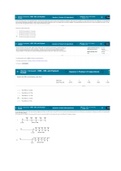All 15 results
Sort by
Best selling Engineering Economy notes
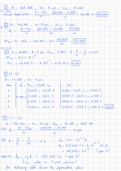
-
HW12 - Chapter 7: Depreciation and Income Taxes
- Other • 3 pages • 2023 Popular
-
- $2.99
- + learn more
It discusses the different methods of depreciation (such as straight-line, declining balance, and sum-of-the-years' digits), how to calculate depreciation expenses, and the impact of different depreciation methods on income taxes. The chapter also covers the basics of income taxes, including the different types of taxes and tax rates, tax deductions and credits, and how to calculate income tax expenses.
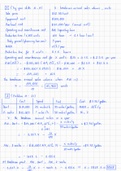
-
HW10_Break-even analysis
- Other • 2 pages • 2023 Popular
-
- $2.99
- + learn more
Break-even analysis is a tool used in engineering economy to determine the point at which total revenue equals total costs, resulting in neither a profit nor a loss. The break-even point is the level of production or sales at which the total revenue generated by a product or service equals the total cost of producing it.
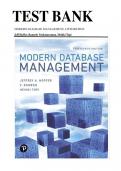
-
Test Bank for Modern Database Management, 13th Edition, Jeff Hoffer, Ramesh Venkataraman, Heikki Topi ISBN: 9780134877006 Chapter 1-14 Complete Guide.
- Exam (elaborations) • 374 pages • 2024 Popular
-
- $19.99
- + learn more
Test Bank for Modern Database Management, 13th Edition, Jeff Hoffer, Ramesh Venkataraman, Heikki Topi ISBN: 9780134877006 Chapter 1-14 Complete Guide. TABLE OF CONTE NTS I. The Context of Database Management 1. The Database Environment and Development Process II. Database Analysis and Logical Design 2. Modeling Data in the Organization 3. The Enhanced E-R Model 4. Logical Database Design and the Relational Model III. Database Implementation and Use 5. Introduction to SQL 6. Advanced SQL 7. Datab...
Do you also write study notes yourself? Put them up for sale and earn every time your document is purchased.
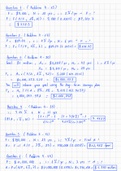
-
HW4_Equivalence Calculations_P,F,A,N_EngEconomics
- Other • 2 pages • 2023 Popular
- Available in package deal
-
- $2.99
- + learn more
Equivalence calculations using the four factors - present worth (P), future worth (F), annual worth (A), and nominal rate (N) - are commonly used to compare and evaluate alternative investment options. Present worth (P) is the value today of a series of future cash flows, calculated by discounting them using a given interest rate. Future worth (F) is the value at a future time of a series of present cash flows, calculated by compounding them using a given interest rate. Annual worth (A) is th...
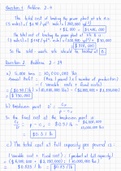
-
HW3_Cost Concepts and Design Economics_EngEconomics
- Other • 3 pages • 2023 Popular
- Available in package deal
-
- $2.99
- + learn more
Cost concepts refer to the various types of costs that are involved in a project, including direct costs (such as labor and materials) and indirect costs (such as overhead and administration expenses). These costs are analyzed and quantified in order to determine the total cost of a project. Understanding cost concepts is important for engineers because it allows them to accurately estimate the costs associated with a project and identify areas where cost savings can be made. Design economics...
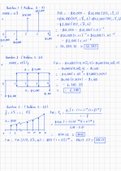
-
HW7_Profitability Measures (PW, FW, AW)_EngEconomics
- Other • 2 pages • 2023 Popular
- Available in package deal
-
- $2.99
- + learn more
The three most commonly used profitability measures are present worth (PW), future worth (FW), and annual worth (AW). Each measure provides a different perspective on the profitability of an investment, and engineers can use them in combination to make informed decisions about the use of resources. Present worth (PW) is the value of all future cash flows of an investment at the present time. Engineers use the present worth factor to calculate the present worth of an investment, taking into ac...
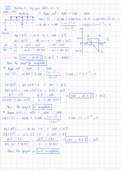
-
HW11_Sensitivity Analysis_Engineering Economics
- Other • 5 pages • 2023 Popular
-
- $2.99
- + learn more
Sensitivity analysis is an important tool in engineering economy that is used to determine how changes in input variables affect the output of an economic analysis. It involves varying one or more of the input variables in a model to determine the effect on the output.

-
HW2_Engineering Economic Analysis_EE
- Other • 1 pages • 2023 Popular
- Available in package deal
-
- $2.99
- + learn more
Engineering economic analysis is a branch of engineering that deals with the evaluation of engineering projects and investment options from a financial perspective. It involves the application of mathematical and economic principles to assess the feasibility, profitability, and risk of engineering projects.
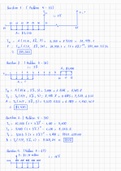
-
HW5_Deferred Annuities and More Complicated Equivalence Calculations_EE
- Other • 2 pages • 2023 Popular
- Available in package deal
-
- $2.99
- + learn more
A deferred annuity is an annuity that does not begin making payments until a specified date in the future. In engineering economy, deferred annuities are often used to evaluate investments in which cash inflows or outflows are expected to occur at a future date. Engineers use present worth, future worth, annual worth, and nominal rate factors to calculate the value of deferred annuities and compare them to other investment options. In more complicated equivalence calculations, engineers may u...

-
HW_questions_Chap2 to7_Engineering Economics.pdf
- Other • 9 pages • 2023 Popular
- Available in package deal
-
- $5.49
- + learn more
Provide questions for homework solutions in another files from chapter 2 to chapter 7
Newest Engineering Economy summaries

-
Test Bank for Modern Database Management, 13th Edition, Jeff Hoffer, Ramesh Venkataraman, Heikki Topi ISBN: 9780134877006 Chapter 1-14 Complete Guide.
- Exam (elaborations) • 374 pages • 2024 New
-
- $19.99
- + learn more
Test Bank for Modern Database Management, 13th Edition, Jeff Hoffer, Ramesh Venkataraman, Heikki Topi ISBN: 9780134877006 Chapter 1-14 Complete Guide. TABLE OF CONTE NTS I. The Context of Database Management 1. The Database Environment and Development Process II. Database Analysis and Logical Design 2. Modeling Data in the Organization 3. The Enhanced E-R Model 4. Logical Database Design and the Relational Model III. Database Implementation and Use 5. Introduction to SQL 6. Advanced SQL 7. Datab...

-
Homework questions and solutions for chapter 2 to 7 in Engineering Economics course
- Package deal • 7 items • 2023 New
-
- $6.49
- + learn more
Homework questions and solutions for chapter 2 to 7 in Engineering Economics course including topics: Engineering Economics Analysis, Cost concepts and Design Economics, Equivalence Calculations (P,F,A,N), Deferred Annuities and More Complicated Equivalence Calculations, Uniform and Geometric Gradients, Profitability Measures (PW, FW, AW)
Provide questions for homework solutions in another files from chapter to 8 chapter 12
Do you also write study notes yourself? Put them up for sale and earn every time your document is purchased.

-
HW_questions_Chap2 to7_Engineering Economics.pdf
- Other • 9 pages • 2023 New
- Available in package deal
-
- $5.49
- + learn more
Provide questions for homework solutions in another files from chapter 2 to chapter 7

-
HW11_Sensitivity Analysis_Engineering Economics
- Other • 5 pages • 2023 New
-
- $2.99
- + learn more
Sensitivity analysis is an important tool in engineering economy that is used to determine how changes in input variables affect the output of an economic analysis. It involves varying one or more of the input variables in a model to determine the effect on the output.

-
HW3_Cost Concepts and Design Economics_EngEconomics
- Other • 3 pages • 2023 New
- Available in package deal
-
- $2.99
- + learn more
Cost concepts refer to the various types of costs that are involved in a project, including direct costs (such as labor and materials) and indirect costs (such as overhead and administration expenses). These costs are analyzed and quantified in order to determine the total cost of a project. Understanding cost concepts is important for engineers because it allows them to accurately estimate the costs associated with a project and identify areas where cost savings can be made. Design economics...

-
HW12 - Chapter 7: Depreciation and Income Taxes
- Other • 3 pages • 2023 New
-
- $2.99
- + learn more
It discusses the different methods of depreciation (such as straight-line, declining balance, and sum-of-the-years' digits), how to calculate depreciation expenses, and the impact of different depreciation methods on income taxes. The chapter also covers the basics of income taxes, including the different types of taxes and tax rates, tax deductions and credits, and how to calculate income tax expenses.

-
HW5_Deferred Annuities and More Complicated Equivalence Calculations_EE
- Other • 2 pages • 2023 New
- Available in package deal
-
- $2.99
- + learn more
A deferred annuity is an annuity that does not begin making payments until a specified date in the future. In engineering economy, deferred annuities are often used to evaluate investments in which cash inflows or outflows are expected to occur at a future date. Engineers use present worth, future worth, annual worth, and nominal rate factors to calculate the value of deferred annuities and compare them to other investment options. In more complicated equivalence calculations, engineers may u...

-
HW7_Profitability Measures (PW, FW, AW)_EngEconomics
- Other • 2 pages • 2023 New
- Available in package deal
-
- $2.99
- + learn more
The three most commonly used profitability measures are present worth (PW), future worth (FW), and annual worth (AW). Each measure provides a different perspective on the profitability of an investment, and engineers can use them in combination to make informed decisions about the use of resources. Present worth (PW) is the value of all future cash flows of an investment at the present time. Engineers use the present worth factor to calculate the present worth of an investment, taking into ac...

-
HW4_Equivalence Calculations_P,F,A,N_EngEconomics
- Other • 2 pages • 2023 New
- Available in package deal
-
- $2.99
- + learn more
Equivalence calculations using the four factors - present worth (P), future worth (F), annual worth (A), and nominal rate (N) - are commonly used to compare and evaluate alternative investment options. Present worth (P) is the value today of a series of future cash flows, calculated by discounting them using a given interest rate. Future worth (F) is the value at a future time of a series of present cash flows, calculated by compounding them using a given interest rate. Annual worth (A) is th...

How much did you already spend on Stuvia? Imagine there are plenty more of you out there paying for study notes, but this time YOU are the seller. Ka-ching! Discover all about earning on Stuvia

